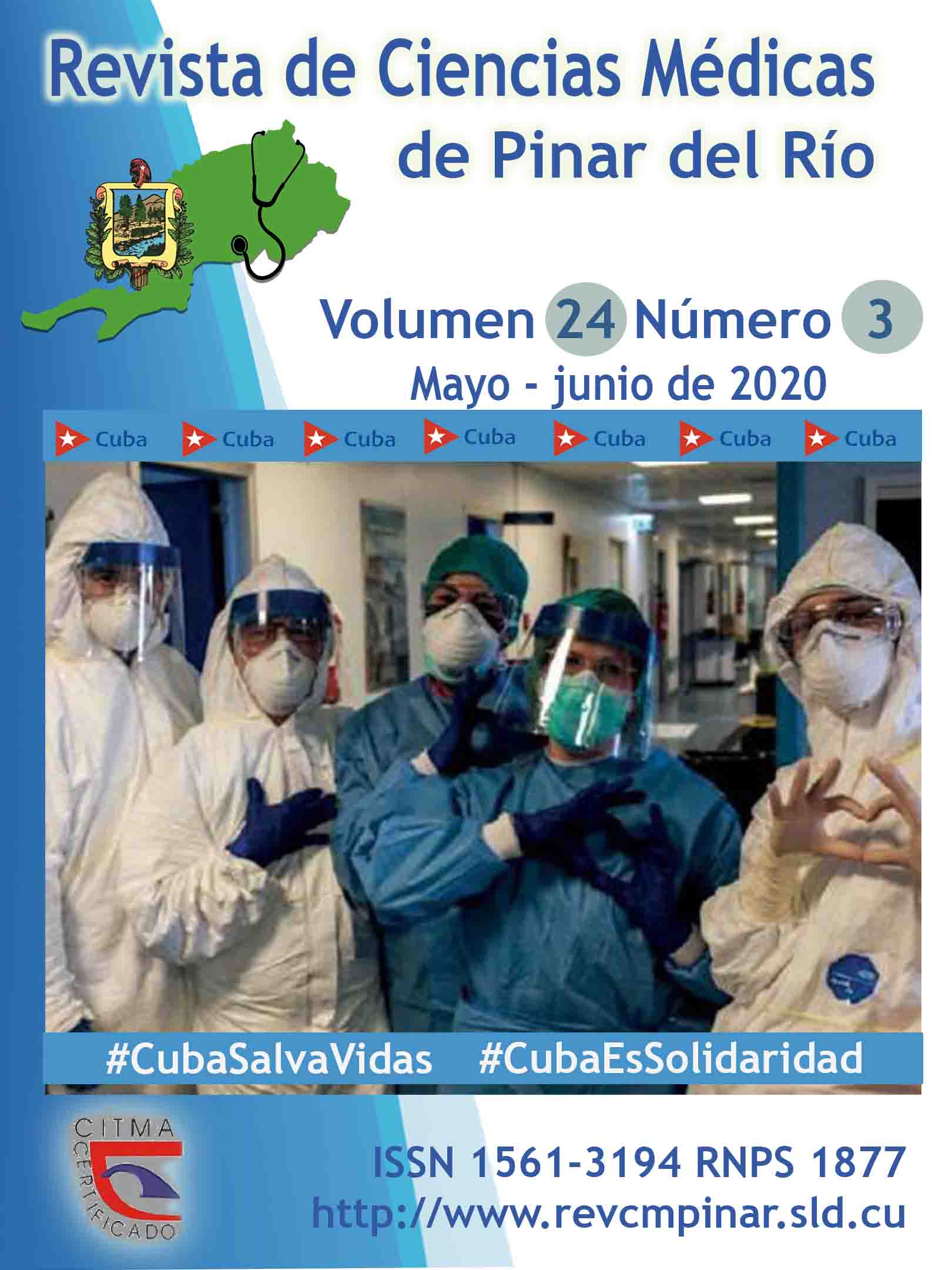Cambios en variables hematológicas y velocidad de sedimentación globular de pacientes no críticos con la COVID-19
Palabras clave:
COVID-19, FACTORES EPIDEMIOLÓGICOS, PACIENTE, HEMATOLOGÍA, PRUEBA DE LABORATORIO.Resumen
Introducción: las pruebas de hematología clínica y la velocidad de sedimentación globular (VSG) se han utilizado como marcadores de evolución clínica en pacientes con la COVID-19.
Objetivo: analizar los cambios de variables hematológicas y VSG en pacientes diagnosticados con la COVID-19 en estado no crítico, ingresados en el Hospital Provincial Docente Clínico Quirúrgico Dr. “León Cuervo Rubio” de Pinar del Río, entre el 16 de marzo y el 4 de mayo de 2020.
Métodos: se realizó un estudio observacional analítico y longitudinal prospectivo con datos de 44 pacientes no críticos con la COVID-19. Se examinaron muestras de: hemoglobina, hematocrito, conteo global de leucocitos, neutrófilos, linfocitos, células de tamaño medio y la eritrosedimentación; al ingreso, a las 48 h, al octavo día y al egreso. Se analizaron los cambios longitudinales de dichas variables por medio de la prueba no paramétrica de Friedman para k muestras relacionadas.
Resultados: las variables hematológicas: hemoglobina, hematocrito, conteo global de leucocitos, neutrófilos y linfocitos no tuvieron modificaciones significativas durante el seguimiento. Solo las células de tamaño medio disminuyeron significativamente en los niños, al comparar su valor medio al egreso con relación al ingreso (p=0,028) y al segundo día de hospitalización (p=0,01). En los pacientes masculinos adultos, la VSG disminuyó significativamente al octavo día y al alta médica, con relación a su valor al ingreso (p=0,008).
Conclusiones: los cambios observados en las variables hematológicas evaluadas, especialmente el de las células de tamaño medio en niños, y eritrosedimentación en hombres con la COVID-19 en estado no crítico, responden a una evolución clínica favorable.
Descargas
Citas
1. Zhu N, Zhang D, Wang W, Li X, Yang B et al. A Novel Coronavirus from Patients with Pneumonia in China, 2019. N Engl J Med [Internet]. 2020 Feb [citado 19/5/2020]; 382(8): [aprox. 6p.]. Disponible: https://www.nejm.org/doi/full/10.1056/NEJMoa2001017
2. WHO. Coronavirus disease (COVID-19) pandemic [Internet]. WHO; 2020. [actualizado 24 May 2020; citado 25/05/2020]. Disponible en: https://www.who.int/emergencies/diseases/novel-coronavirus-2019
3. Corman VM, Landt O, Kaiser M, Kaiser M, Molenkamp R. Detection of 2019 novel coronavirus (2019-nCoV) by real-time RT-PCR. Rev Eur Surveill [Internet]. 2020 Ene 25 [citado 19/5/2020]; 25(3): [aprox. 8p.]. Disponible en: https://www.ncbi.nlm.nih.gov/pmc/articles/PMC6988269/
4. Eugene B, Lian VC, Seok S, Hsiang G, Hsiang S. Hematologic parameters in patients with COVID-19 infection. AJH [Internet]. 2020 Ene 25 [citado 20/5/2020]; 95(6): [aprox. 5p.]. Disponible en: https://onlinelibrary.wiley.com/doi/epdf/10.1002/ajh.25774
5. Lapic I, Rogic D, Plebani M. Erythrocyte sedimentation rate is associated with severe coronavirus disease 2019 (COVID-19): a pooled analysis. Clin Chem Lab Med [Internet]. 2020 May [citado 20/5/2020]; 58(7): [aprox. 2p.]. Disponible en: https://www.degruyter.com/view/journals/cclm/ahead-of-print/article-10.1515-cclm-2020-0620/article-10.1515-cclm-2020-0620.xml
6. Frater JR, Zini G, d’Onofrio G, Rogers HJ. COVID-19 and the clinical hematology laboratory. ISLH [Internet]. 2020 Abr [citado 21/5/2020]; 42(s1): [aprox. 7p.]. Disponible en: https://onlinelibrary.wiley.com/doi/abs/10.1111/ijlh.13229
7. Misnisterio de Salud Pública. Protocolo de actuación nacional para la covid-19. (Versión provisional para uso del personal de salud que labora en el enfrentamiento a los casos) Versión 1.4. [Internet]. Infomed; Abril 2020 [actualizado Abr 2020; citado 23/05/2020] Disponible:http://www.sld.cu/anuncio/2020/05/11/ministerio-de-salud-publica-protocolo-de-actuacion-nacional-para-la-covid-19
8. Sociedad Cubana de Patología Clínica [Internet]. Cuba: Infomed; 2020 [actualizado 19 May 2020; citado 20/05/2020]. Disponible en: http://www.sld.cu/uvs/patologiaclinica/
9. García de Lorenzo Mateos A, Quintana Díaz M. Aspectos hematológicos en la sepsis grave. REMI [Internet]. 2004 Abr [citado 20/05/2020]; 4(12). Disponible: https://remi.uninet.edu/2004/12/REMIC20.htm
10. Wenzhong L, Hualan L. COVID-19: Attacks the 1-Beta Chain of Hemoglobin and Captures the Porphyrin to Inhibit Human Heme Metabolism. Rev Chem R xiv [Internet]. 2020 Abr 13 [citado 21/5/2020]; 26(7): [aprox. 23p.]. Disponible en: https://chemrxiv.org/articles/COVID-19_Disease_ORF8_and_Surface_Glycoprotein_Inhibit_Heme_Metabolism_by_Binding_to_Porphyrin/11938173
11.Zhang H, Wang X, Fu Z, Luo M, Zhang Z. Potential Factors for Prediction of Disease Severity of COVID-19 Patients. Med Rxiv [Internet]. 2020 Mar [citado 19/05/2020]. Disponible en: https://www.medrxiv.org/content/10.1101/2020.03.20.20039818v1
12. Didangelos A. Neutrophil involvement in Covid-19. Preprint [Internet]. 2020 Abr [citado 19/05/2020]: [aprox. 5p.]. Disponible: https://www.preprints.org/manuscript/202004.0363/v2
13. Henry BM, Lippi G, Plebani M. Laboratory abnormalities in children with novel coronavirus disease 2019. Clin Chem Lab Med [Internet]. 2020 Jun 25 [citado 12/5/2020]; 58(7): [aprox. 4p.]. Disponible en: https://pubmed.ncbi.nlm.nih.gov/32172227/
14. Mozzini Ch, Girelli D. The role of Neutrophil Extracellular Traps in Covid-19: only an hypothesis or a potential new field of research? Thromb Res [Internet]. 2020 Jul [citado 24/5/2020]; 191: [aprox. 1p.]. Disponible en: https://www.ncbi.nlm.nih.gov/pmc/articles/PMC7184981/
15. Merad M, Martin JC. Pathological inflammation in patients with COVID-19: a key role for monocytes and macrophages. Nad Rev Im [Internet]. 2020 May [citado 21/5/2020]; 20(6): [aprox. 7p.]. Disponible en: https://pubmed.ncbi.nlm.nih.gov/32376901/
Descargas
Publicado
Cómo citar
Número
Sección
Licencia
Aquellos autores/as que tengan publicaciones con esta revista, aceptan los términos siguientes:- Los autores/as conservarán sus derechos de autor y garantizarán a la revista el derecho de primera publicación de su obra, el cuál estará simultáneamente sujeto a la Licencia de reconocimiento de Creative Commons que permite a terceros compartir la obra siempre que se indique su autor y su primera publicación esta revista.
- Los autores/as podrán adoptar otros acuerdos de licencia no exclusiva de distribución de la versión de la obra publicada (p. ej.: depositarla en un archivo telemático institucional o publicarla en un volumen monográfico) siempre que se indique la publicación inicial en esta revista.
- Se permite y recomienda a los autores/as difundir su obra a través de Internet (p. ej.: en archivos telemáticos institucionales o en su página web) antes y durante el proceso de envío, lo cual puede producir intercambios interesantes y aumentar las citas de la obra publicada. (Véase El efecto del acceso abierto).



